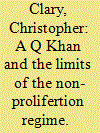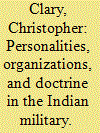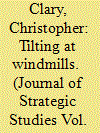|
|
|
Sort Order |
|
|
|
Items / Page
|
|
|
|
|
|
|
| Srl | Item |
| 1 |
ID:
057865


|
|
|
| 2 |
ID:
163810


|
|
|
|
|
| Summary/Abstract |
Is India shifting to a nuclear counterforce strategy? Continued aggression by Pakistan against India, enabled by Islamabad's nuclear strategy and India's inability to counter it, has prompted the leadership in Delhi to explore more flexible preemptive counterforce options in an attempt to reestablish deterrence. Increasingly, Indian officials are advancing the logic of counterforce targeting, and they have begun to lay out exceptions to India's long-standing no-first-use policy to potentially allow for the preemptive use of nuclear weapons. Simultaneously, India has been acquiring the components that its military would need to launch counterforce strikes. These include a growing number of accurate and responsive nuclear delivery systems, an array of surveillance platforms, and sophisticated missile defenses. Executing a counterforce strike against Pakistan, however, would be exceptionally difficult. Moreover, Pakistan's response to the mere fear that India might be pursuing a counterforce option could generate a dangerous regional arms race and crisis instability. A cycle of escalation would have significant implications not only for South Asia, but also for the broader nuclear landscape if other regional powers were similarly seduced by the temptations of nuclear counterforce.
|
|
|
|
|
|
|
|
|
|
|
|
|
|
|
|
| 3 |
ID:
158432


|
|
|
|
|
| Summary/Abstract |
The article explains when, why, and how Indian Army doctrine has changed since 1947. It traces Indian Army doctrinal evolution from defensive defense from 1947 to the mid-1960s, toward maneuver warfare after 1971, greater mechanization in the 1980s, and an emphasis on rapid, limited offensive strikes after 2002. It argues that in the absence of civilian intervention, the Indian Army has followed patterns predicted by organizational theory. The Indian Army has tended to avoid major doctrinal evolution and when doctrinal change has taken place it has consistently moved away from defensive orientations in favor of doctrines that maximize the initiative available to future Indian Army leaders to undertake offensive action. Doctrinal innovation has also been hampered by high turnover and apolitical selection of Indian Army chiefs, which inhibits continuity in efforts at doctrinal reform and modernization.
|
|
|
|
|
|
|
|
|
|
|
|
|
|
|
|
| 4 |
ID:
187980


|
|
|
|
|
| Summary/Abstract |
Russia–Pakistan relations have improved since the end of the Cold War. While that trend is likely to continue, Russia is unlikely to transform Pakistan’s difficult strategic circumstances. Russia is insufficiently wealthy to provide enough aid and investment to revitalize Pakistan’s economy. Russia is also too concerned with maintaining access to the Indian defense market to increase defense sales to Pakistan more than modestly. This article reviews what I call the constraints of geoeconomics, where the relatively small size of the Russian and Pakistani economies combines with the considerable distance between them to limit Russian–Pakistani ties despite periodic official interest in deepening them. It situates these current obstacles in the context of the historic Soviet–Pakistani relationship, which was similarly constrained by distance, great power politics, and Indian concerns.
|
|
|
|
|
|
|
|
|
|
|
|
|
|
|
|
| 5 |
ID:
156279


|
|
|
| 6 |
ID:
099797


|
|
|
|
|
| Publication |
New Delhi, IDSA, 2010.
|
| Description |
42p.
|
| Series |
IDSA occasional paper no. 12
|
| Standard Number |
9788186019740
|
|
|
|
|
|
|
|
|
|
|
|
Copies: C:2/I:0,R:0,Q:0
Circulation
| Accession# | Call# | Current Location | Status | Policy | Location |
| 055344 | 363.1799095491/CLA 055344 | Main | On Shelf | General | |
| 055345 | 363.1799095491/CLA 055345 | Main | On Shelf | General | |
|
|
|
|
| 7 |
ID:
164662


|
|
|
|
|
| Summary/Abstract |
This article examines decision-making mistakes made by U.S. President Nixon and national security advisor Kissinger during the 1971 India-Pakistan crisis and war. It shows that Nixon and Kissinger routinely demonstrated psychological biases that led them to overestimate the likelihood of West Pakistani victory against Bengali rebels as well as the importance of the crisis to broader U.S. policy. The evidence fails to support Nixon and Kissinger’s own framing of the 1971 crisis as a contest between cool-headed realpolitik and idealistic humanitarianism, and instead shows that Kissinger and Nixon’s policy decisions harmed their stated goals because of repeated decision-making errors.
|
|
|
|
|
|
|
|
|
|
|
|
|
|
|
|
|
|
|
|
|